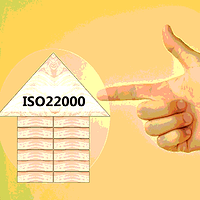Inspections, Part 3: Compliance

Of all the issues with which I have grappled in my career as a sanitarian, the most difficult is compliance. Ideally, the goal of code compliance is to protect consumers from foodborne diseases and to reduce the risk of foodborne hazards. If properly executed, it does just that. On its face, it sounds quite simple: If a code violation is observed and properly documented during the inspection process, that violation must be corrected. Period. All too often, however, it does not work that way in the real world. I have come to the realization that compliance requires all the knowledge and skill of both the inspector and the operator to reach its stated goal. Compliance, therefore, is a collaborative effort between the inspector and the inspected. Since compliance strategy is as much of an art form as it is a legal obligation, I thought it would be best to tackle this subject on the heels of my previous columns on inspector and operator expectations.
Changing the Compliance Paradigm
Compliance efforts often do not improve public health or safety, particularly when the obvious question—What is to be achieved in correcting the violation?—is not asked. In fact, many sanitarians can cite examples in which correcting a violation has created or exacerbated poor food protection and cross-contamination prevention practices. Sure enough, the violation is abated, but the consequence of this action resulted in other problems of far greater risk.
In my repertoire of war stories, I can distinctly recall a situation at the beginning of my career as a state sanitarian that left a notable impression and made me question the effectiveness of compliance without examining the total operation and facilities. I call this “compliance in a vacuum.” I was assigned to audit the food establishments in a metropolitan community; not so much for code violations, but rather, to determine if the local inspections were adequate to meet the public health needs. As fate would have it, I visited a small establishment before and after local code compliance efforts. It was a small mom-and-pop hero shop (that’s what we call grinders, subs and po’boys in the East) with a limited menu and open only for lunch. Business was brisk. The family had owned and operated the business for at least two generations without any changes to the physical plant to meet the ever-evolving new code requirements.
The preparation and storage areas were meticulously clean and food protection—even for that time—was exceptionally well managed. Food turnover was rapid and surprisingly, the shop had more than adequate hot and cold holding facilities. The work area was quite small and rather cramped but adequate for a two-person operation, one at the sandwich board and the other at the cash register. It had a one-compartment sink with a drain board that was used as a prep sink and for utensil and intermittent handwashing. The main handwashing sink was in the toilet, which was not accessible to the public but convenient to the kitchen. The patriarch who ran the facility believed in bleach and used it religiously. I think that everyone would rate this operation quite highly. I certainly did, and bought my lunch there on many occasions.
As the result of an unrelated press article and some political pressure, however, the local health officials insisted on upgrading universal compliance to their Retail Food Establishment Code. They required the owner to upgrade the facility and to install a three-compartment sink in lieu of the single compartment unit and a separate handwashing sink adjacent to it. Needless to say, compliance was a disaster. To fit the sinks in the area, one of two reach-in refrigerators had to go as did a small bain-marie used to keep the meatballs and sausage and peppers hot. The result was that all food was now crammed into one refrigerator and the bain-marie was supplanted by two crock pots that were placed on a Formica-clad board covering the third sink compartment during their operation. Of necessity, the handwashing sink became a desk, but it had the appropriate soap and towels. Needless to say, the facility complied with the spirit of the code, but in so doing, it created a monster. I have never forgotten this lesson.
Code compliance is obviously a function of the law, but the law makes no distinction between its administrative mandates, good science and old fashioned commonsense. Nor does the law leave any latitude for interpretation, at least not in spirit. To cite a second example of compliance gone awry, a food operation at a local detention facility in which several thousand meals a day were prepared was under order to clean up its act. Much of my work is in litigation support as a court-appointed monitor. In this case, the jail was under a consent decree. An extremely detailed and well-crafted inspection report was prepared by a competent sanitarian and presented to the court in fulfillment of the monitoring process. The deficiencies that were cited numerous but not serious and the judge ordered that they be corrected forthwith. A date was set for a re-inspection and I accompanied the plaintiff’s and defendant’s experts as they went through the facility. To be sure, every deficiency that was listed in the original report was dutifully ameliorated. However, I found the same violations, newly created, but in different areas of that same facility. The conditions precluding these violations still existed. Because these citations were not exactly quantifiable or related to the jail’s actual operation, they were deemed more of a nuisance than something that could influence risk. Compliance was the result of a judge’s order, rather than the impetus to improve food protection. Obviously, there was little to no dialogue between the parties involved and the outcome was as expected. Money spent, no change.
In each example, compliance was not approached as a function of critical control points, Good Manufacturing Practices (GMPs), economic reality or using the basic principles of consumer expectations and protection. I propose that we change the compliance paradigm and seek approaches that truly meet the stated goals. While I do not propose to do away with code compliance, I would like to see a different approach. Granted, there are some operators that need the big stick, but they are growing fewer in number as a result of mandatory food safety education and certification programs as well as heightened customer expectations. I will never argue that the presence of adulterated food, obvious cross-contamination, time and temperature abuses, poor personal hygiene and employee health issues, vermin, poor housekeeping, or plumbing cross-connections are negotiable. These code violations must be remedied by any means necessary.
A New Approach to Compliance
Our traditional approach to food code compliance falls into two risk-based categories: violations that are considered serious enough to demand immediate correction and those that are non-critical, where the facility has the luxury of time to make changes. However, ameliorating the immediate health risk may not entirely satisfy the demand for food protection. I cannot think of any critical operational violation that does not have a non-critical component. Therefore, selected non-critical violations should be grouped with those of a more critical nature and concomitant compliance sought accordingly.
I have often wondered how our seemingly disjointed compliance efforts yield the desired result of lowering the risk of foodborne illnesses. I propose that consideration be given to a different approach—one that involves compliance that is based on risk and desired outcome, and one that is a negotiated settlement between the inspector and the inspected. In this context, I would like to suggest a few ways to make this possible:
Look for root causes. The first way to approach compliance begins by determining root causes for the violations. Every violation is a consequence of a change in circumstance and/or a failure in equipment and procedures, policy and practice, or human error. This means that every violation has a root cause. By examining the deficiency as a “system” or benchmarking violations, a logical approach to compliance can be taken. Looking for the root causes can also provide guidance for interim improvements. This will substantially lower the risk of foodborne illness during the compliance process through its completion.
Use hazard analysis. We use Hazard Analysis and Critical Control Points (HACCP) as a prevention-based food safety system. HACCP assesses the inherent risks attributable to a product or process and then determines the necessary steps that will control these identified risks. HACCP is basically a food safety map to the facility. If done correctly, it outlines personnel traffic patterns and the movement of foods through receipt, storage, preparation and service.
If we start with the menu and take each item through a cursory hazard analysis exercise, we can begin to develop a picture that identifies the deficiency that will exert the greatest risk leading to foodborne disease. I am always amazed at the emphasis on many inspection reports on such misplaced indicators as replacing missing covers on fluorescent light strips, repairing damaged wall and surface tiles and demanding that all windows are screened, even those that do not or cannot be opened. Try letting a hazard analysis guideline determine how violations are grouped, prioritized and scheduled for correction. Following this, we can then worry about light covers, tiles and screens.
Use good science and common sense. For a moment, let’s focus on foodborne infections. The biology of most infectious organisms is fairly well known and understood. We can predict their optimal growth conditions and conversely, we understand the dynamics of cleaning, sanitizing and pasteurizing. We can estimate the bio-loading of anything in our physical plant within order of magnitude accuracy and we can predict the bioburden of any food product at any stage along its process. Therefore, it is possible to seek compliance based on actual biological considerations. We can consider eliminating excessive handling and other potentially contaminating processes; adjusting the temperature and time of cool-down and re-thermaling; altering the pH and water activity of certain foods; and even go so far as substituting non-hazardous foods and handling practices for those of greater risk. We need to determine what changes in the operation and the environment are both prudent and practical to minimize microbiological growth, transference and contamination potential.
Consider cost-effectiveness. Science teaches us that there is no such thing as zero risk. Experience teaches us that there is no such thing as 100% code compliance. Somehow we learn the concept of acceptable risk and acceptable levels of compliance through life’s lessons. The closer our demands are to attaining unity, whether in risk or compliance, the greater is the cost. In all things, there comes a point of diminishing returns. We can, however, expect optimum compliance where “optimum” is defined as the degree that is most favorable to some end; namely, acceptable risk. It is therefore incumbent upon us in the public sector to seek that optimal level without placing an undue financial burden on the inspected. This means that the regulatory community has the obligation of considering economic ramifications in its quest toward compliance.
Use plan review as a compliance tool. I cannot leave this discussion without mentioning the importance of the regulatory plan review process. A good plan review program is the ideal preventive tool in food safety because it eliminates problems before they are built into the system. A thorough and professional plan review of a new or remodeled facility is also the best way to avoid code compliance issues. By comparing the original plan review to the current operation, inferences can be made about changes in use and traffic patterns, as well as changes in equipment that may compromise food protection. The plan review, used in conjunction with the inspection report, can provide insights into compliance strategies.
A Stakeholders’ Forum
The FDA Food Code and other relevant publications are silent on the issue of compliance beyond its legal and administrative aspects. I know of no reference that deals with compliance strategies as a function of risk and cost benefit. Yet, we all know that code compliance, and particularly the way we approach the subject, has far-reaching public health and economic considerations. For many of us, compliance is as important as code development and interpretation and should be considered with the same diligence and commitment. I, therefore, would like to see an industry/regulator forum dedicated to this topic, with all stakeholders equally represented.
Forensic sanitarian Robert W. Powitz, Ph.D., MPH, RS, CFSP, is principal consultant and technical director of Old Saybrook, CT-based R.W. Powitz & Associates, a professional corporation of forensic sanitarians who specialize in environmental and public health litigation support services to law firms, insurance companies, governmental agencies and industry. For more than 12 years, he was the Director of Environmental Health and Safety for Wayne State University in Detroit, MI, where he continues to hold the academic rank of adjunct professor in the College of Engineering. He also served as Director of Biological Safety and Environment for the U.S. Department of Agriculture at the Plum Island Animal Disease Center at Greenport, NY. He is the first to hold the title of Diplomate Laureate in the American Academy of Sanitarians, and is a Diplomate in the American Academy of Certified Consultants and Experts and with the American Board of Forensic Engineering and Technology.
Dr. Powitz welcomes reader questions and queries for discussion in upcoming columns. Suggestions can be sent to him directly at sanitarian@juno.com or through his website at www.sanitarian.com.
Looking for a reprint of this article?
From high-res PDFs to custom plaques, order your copy today!









